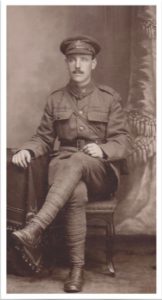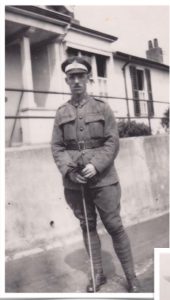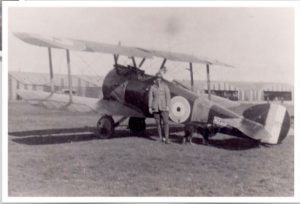32nd Training Depot Station, Royal Air Force

William Douglas Henderson, known better as Douglas, was born on 8 December 1893. He was the son of Alexander Henderson, a draper, and his wife Mary who between them had a total of no less than nine children. When Douglas was very young, the family lived at Clarence Street in Gloucester, although they later moved to Hucclecote to what is today the Royal Oak public house.
After attending King’s School as a chorister, Douglas obtained an apprenticeship at Messrs Nicks and Co, Timber Yard on the Bristol Road. He was a keen sportsman, playing both cricket and rugby and was also a member of Gloucester Rowing Club. In May 1911 however, at the age of
twenty-two, Douglas sought a new life in Canada, initially working as a lumberjack and then taking a job in the motor trade.
On 31 March 1916 he drew on his skills as a motor mechanic and enlisted into the Canadian Army Service Corps as a Driver, proceeding to the Western Front in August of that year. In the Spring of 1918, seeing a future career in aviation, Douglas applied to transfer into the newly formed Royal Air Force and left for England to train as a pilot with the 32nd Training Depot Station (TDS) at Montrose in Scotland. Initially, of course, Douglas flew with an instructor in a two-seater trainer but it was not long before he went solo and learnt to fly the single-seat aircraft he would be using operationally including the famous Camel.
On 28 November 1918, Douglas took off for a practice flight in one of the training school’s Camels, one of a batch of forty that was built from salvaged parts. He left Montrose airfield and headed south to practice aerobatics above the ancient hill fort at Ironshill, putting the Camel through its paces. As he performed one of the acrobatic manoeuvres, probably a turn or a loop, Douglas’s lap strap gave way and he was thrown out of the cockpit. His body was found at Castle Farm near Lunan Bay, the official cause of his death being given as a fracture to the base of the skull.
The subsequent investigation concluded that Douglas was not to blame for the accident, his lap strap had failed under the strain of the aerobatics. Douglas was over six-foot tall and his weight, combined with that of his heavy flying clothing, may have contributed to its failure.

Henderson at Hastings during initial officer training

Henderson at Montrose
